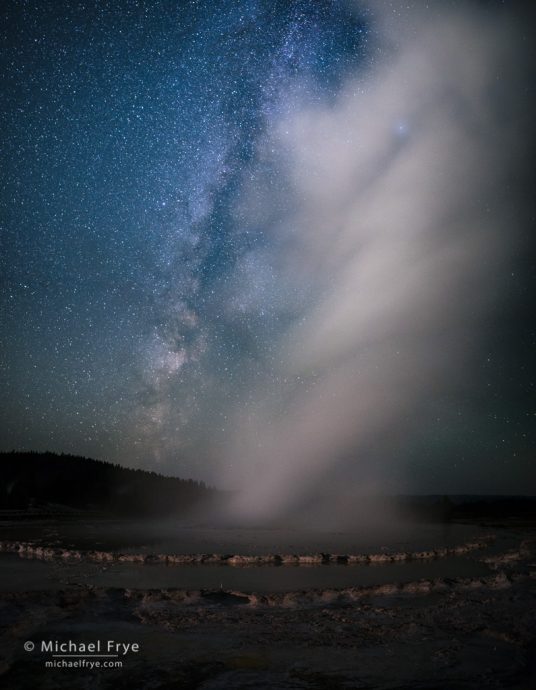
Great Fountain Geyser and the Milky Way, Yellowstone NP, WY, USA. I photographed this geyser two nights in a row. On the first night I joined another photographer from Florida, but on the second night I miraculously had it to myself. This is the one image in this post where I used my own lighting, using two LED panels to add subtle illumination to the geyser and its beautiful terraced pools. This photograph is a stitched three-frame vertical panorama, captured with my 20mm Rokinon lens. Each exposure was 20 seconds at f/2.5, ISO 6400.
Next to Yosemite, Yellowstone might be my favorite national park. But I hadn’t been to Yellowstone since 2003 – way too long! So after watching and photographing the eclipse in Idaho, Claudia and I decided to head to Yellowstone. We started in the remote, quiet, beautiful, southwest corner of the park, near Cave Falls, an area we’d never been to before. Then we moved into the Madison campground, where, miraculously, we had been able to secure a last-minute reservation.
Since it had been so long since our last visit we played tourist a bit, watching Old Faithful erupt one afternoon, and making the journey to Artist Point above the Grand Canyon of the Yellowstone. There were lots of people in the park. It was August, after all, but it didn’t seem that busy 14 years ago, even in summer. We got stuck in an hour-long bison jam in Hayden Valley.
But in the evenings the park emptied out. We watched Grand Geyser erupt late one afternoon, with a modest crowd of people on hand. (Claudia posted a great video on Facebook of the geyser and crowd reaction.) And after sunset we practically had the park to ourselves, save for a few other photographers.
On my previous visits to Yellowstone I had become fascinated with geysers. I studied the bible on the subject, T. Scott Bryan’s The Geysers of Yellowstone, and learned about the character and quirks of the major geysers (and some minor but photogenic ones as well). And in the late ’90s I photographed geysers at night with medium-format film and a large, battery-powered flash. But I wanted to try photographing geysers with new techniques, a modern digital camera, and 20 years more experience.
I started by asking a ranger at the Old Faithful Visitor Center about Beehive Geyser. A ranger at the Old Faithful Visitor Center, who seemed to know a lot about geysers, told me that it had been erupting every 12 to 20 hours, but usually between 14 to 16 hours. It had erupted at 7:15 that morning, so he thought it would probably erupt between 9:00 and 11:00 p.m. that evening. Which seemed like perfect timing for a night photo.
Claudia and I got a late start, arriving at Geyser Hill a little before 10:00 p.m. But it didn’t look like Beehive had erupted yet, as the boardwalk next to it was dry. It was difficult to find a composition that didn’t include the lights and buildings surrounding Old Faithful, but I finally found a view that worked, with the boardwalk as a leading line.
And just in time. As soon as I found this composition Beehive started erupting. The lights from the Old Faithful Inn and Lodge illuminated the geyser perfectly:
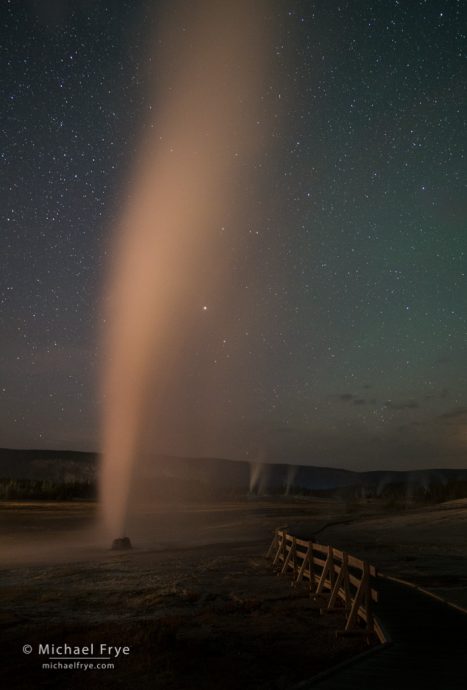
Beehive Geyser at night, Yellowstone NP, WY, USA. Perfect lighting provided by the Old Faithful Inn and Lodge. 20mm, 20 seconds at f/2.5, ISO 6400.
In all I spent four nights photographing the geysers and thermal areas in Yellowstone. Although I almost always add my own lighting to nighttime photographs, in Yellowstone I mostly just used starlight and moonlight, along with the lights from the buildings near Old Faithful, and an occasional car headlight. You’ll find extended captions with the images below to explain how they were made.
Watching a geyser erupt by starlight is an indescribably beautiful and serene experience. Once I waited for Great Fountain Geyser with another photographer from Florida, and sometimes Claudia was with me. And I ran into two photographer friends, Jeff Sullivan and Lori Hibbett, at Grand Prismatic Spring. But often I was completely alone, with Yellowstone’s chief attractions all to myself. What a treat.
And I renewed my love affair with geysers. They’re endlessly fascinating, and I don’t seem to get tired of watching or photographing them. I’ll be back.
— Michael Frye
P.S. Beehive was the first geyser our son Kevin ever saw. On his first trip to Yellowstone in 1997, when he was not quite seven years old, Beehive was erupting regularly every 12 hours (it’s usually more erratic). Our first afternoon in the park that year we went to the Old Faithful Visitor Center, and their geyser-precition board showed that Beehive was due to erupt in 30 minutes. That left just enough time to climb up Geyser hill to see it. As Beehive erupted we stood about 50 feet away on the boardwalk, watching the water pulsing 180 feet over our heads for a solid five minutes. Kevin had little appreciation for lesser geysers after that. He was completely unimpressed when we later viewed Old Faithful, which averages a “mere” 145 feet high, sustains its maximum height for less than a minute, and has to viewed from a much greater distance. Any time we went to view a geyser after that he would ask, “Is it like Beehive?” Well no, not many geysers are like that. He still remembers Beehive 20 years later.
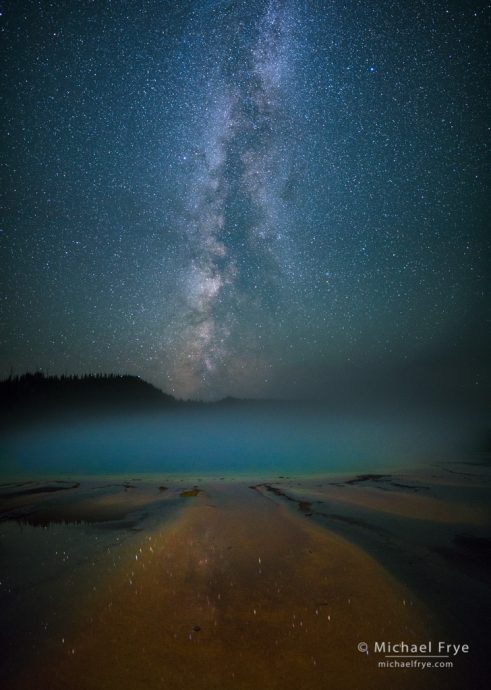
Milky Way over Grand Prismatic Spring, Yellowstone NP, WY, USA. I was surprised that the camera could capture the amazing colors of this spring just by starlight. Another vertical panorama, stitched together from four frames made with my 20mm Rokinon. Each frame was 20 seconds at f/2, ISO 6400.
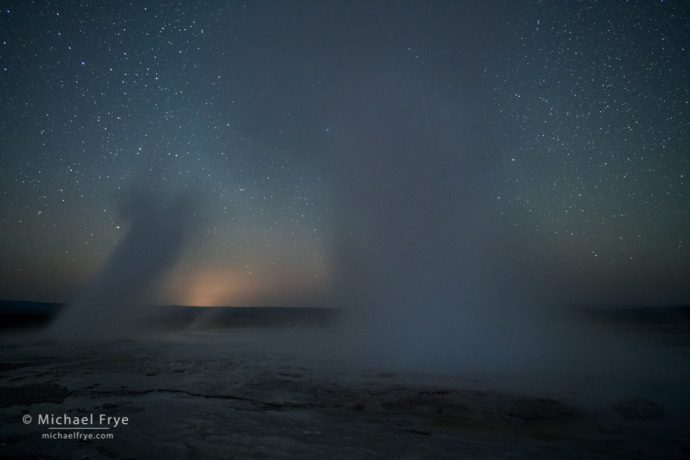
Fountain and Clepsydra Geysers erupting at night, Yellowstone NP, WY, USA (Fountain is on the right). After photographing the setting moon I walked out to photograph Clepsydra Geyser, which erupts almost continuously. But I was surprised to find Fountain Geyser erupting as well. 20mm, 20 seconds at f/2.5, ISO 6400.
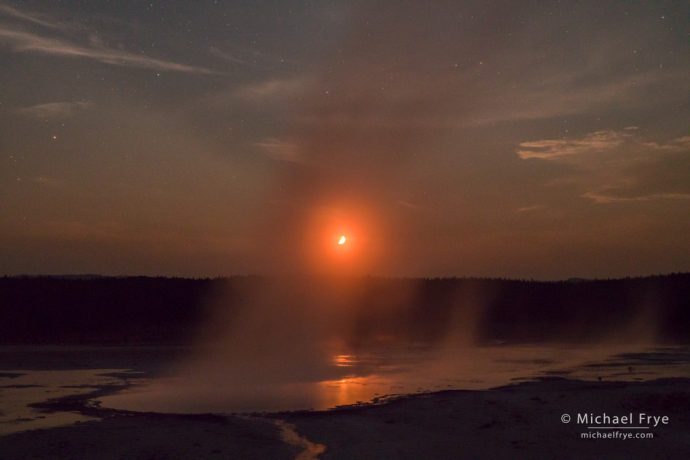
Celestine Pool and the setting moon, Yellowstone NP, WY, USA. On our last night in Yellowstone I photographed the half moon setting through the mist of this spring (and occasional geyser). 50mm, 8 seconds at f/5.6, ISO 6400.
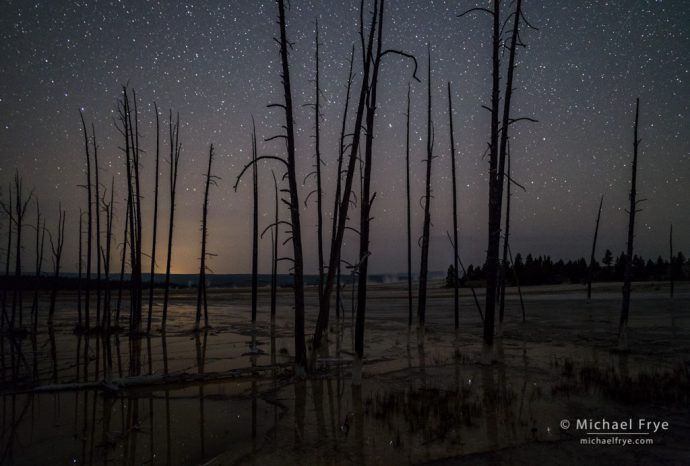
Trees and stars, Lower Geyser Basin, Yellowstone NP, WY, USA. I liked these trees silhouetted against the starry sky, with reflections of both in the water below. 20mm, 20 seconds at f/2.5, ISO 6400.
Related Posts: Eclipse Journey; Nighttime Reflections
Michael Frye is a professional photographer specializing in landscapes and nature. He is the author or principal photographer of The Photographer’s Guide to Yosemite, Yosemite Meditations, Yosemite Meditations for Women, Yosemite Meditations for Adventurers, and Digital Landscape Photography: In the Footsteps of Ansel Adams and the Great Masters. He has also written three eBooks: Light & Land: Landscapes in the Digital Darkroom, Exposure for Outdoor Photography, and Landscapes in Lightroom: The Essential Step-by-Step Guide. Michael has written numerous magazine articles on the art and technique of photography, and his images have been published in over thirty countries around the world. Michael has lived either in or near Yosemite National Park since 1983, currently residing just outside the park in Mariposa, California.









These images are spectacular! Thank you for sharing them. I think the Grand Prismatic Spring is my favorite image ever of it. And it is remarkable that you got that much color by starlight! Do you think the a7rii (thinking of getting one) is responsible or might my a7 do about as well? Also, I’m curious what kind of LED panels you’re using? I’ve been thinking about getting 1 or 2. Many thanks Michael!
Thanks Joolz! I think any camera that handles low light levels and high ISO images well would show the color. I’m sure the a7 would work. My LED light panels are the cheap Neewer brand recommended near the end of this article. I don’t use them often:
http://www.lowlevellighting.org
Many thanks, Michael! Oops, I sort of looked for the name of the light panels but obviously missed it. I appreciate your patience!
Thanks for sharing. I need to go back now that I am a MW freak and we have newer high ISO cameras and fast lenses. My favorite is the Grand Prismatic as well. I see that you are also becoming intrigued by the stars more than ever.
You’re welcome Karl. I wouldn’t say that I’m more intrigued by stars than ever. I’ve been doing night photography for more than 20 years now! And the Milky Way is great, but there are so many photos of it these days that I’d rather put something else more interesting in the sky if I can.
Awesome shots as usual Michael. We were in Yellowstone in July this year and we had 2 nights of MW shooting ourselves. It was a family affair, my wife, granddaughter (9yrs), and myself. My wife and granddaughter entered a couple of their MW shots into the Humboldt county fair. Granddaughter had one of the MW with Old Faithful erupting in the foreground while being lit up by a light from the property. She was awarded a first place ribbon from the fair, a first place ribbon by the Redwood Camera Club, and a Best of Category ribbon as well. My wife got a second place ribbon for her shot of the MW with some light painting of the Grand Prismatic Spring. It was an amazing trip for sure, so many photo ops there can’t wait to get back. Your photos continue to inspire and educate us. Thank you for continuing to post your work and technique to achieve your masterpieces.
Thanks Jeff, and congratulations to your wife and Granddaughter!
Awesome photographs Michael. You just nailed it with your great work and great timing. You’re awesome. Milky Way over Grand Prismatic Spring is my favorite. Thanks for sharing this spectacular photos with us.
Thanks very much Brian!
These are the most mysterious and special images of Yellowstone that I have ever seen. Your images are always beautiful but these are my favorites because of the mystery that extends beyond the subject matter.
Thanks so much Betsy!
This images are gorgeous! I was in Yellowstone from 20th to 26th but didn’t went out during the night in respect to the bears.
But thr good news are: during the eclipse we did a hike in the upper geyser basin from Old Faithful to Buiscit Basin and retour and met only 20 people! I wonder why!
I get some nice day shots of Beehive, Great and Castle Geyser.
Sometime I will join one of your workshops in Yosemite.
Thanks Marc! Bears are a concern in Yellowstone, of course, but I carry bear spray and try not to be overly paranoid. And it’s great that you got to have the park almost to yourself during the eclipse, but… you missed an awesome event!
These images are beautiful! Your composition and technique are inspiring.
Thank you for your generosity of sharing your knowledge.
Gina
Thank you Gina!
Great work Michael. Know those areas well and you really captured the scene.
Thank you Dave!
Great inspirational shots Michael, makes me want to go back to one of my favorite parks as my daughter worked there the previous 2 summers. I was just there in January and managed to get a memorable shot of Old Faithful erupting with the Big Dipper in the background AND a shooting star! How do you like the Rokinon 20mm? Haven’t seen much written about it except one on Lonely Speck.
Thanks Harri, and I’m glad you were able to get some photographs you liked of Old Faithful. I like my Rokinon 20mm, but I do not recommend it to people because I had to test four copies to find a good one. The other three did not focus all the way to infinity.
Michael,
As always, you captured such serene, night time beauty. While I really love the Beehive Geyser photo, it’s the Grand Prismatic Spring photo that made me gasp. I think this image is another home run for you, IMO. The scene is so vibrant, haunting, and leaves me speechless. For me personally, I place Yellowstone #3 on my NP list with YNP and Glacier as #1 & 2. Thanks, again, to you and Claudia for sharing your passion.
Hello Michael. I followed the reading of this great post (once again)by buying the Rokinon 20 mm lens (thinking that what’s good for Michael Frye is good for me!). Now, I notice that Lightroom does not have a camera profile for correction. My question: what do you do? If I use the 24 mm Rokinon (bought too after reading on of your posts) in the meantime, am I “good” to go? Thank you kindly. Regards,
CH
Claude, I do use the profile for the Rok 24 with my Rok 20. It seems to work pretty well – though I do wonder how any profile works with Rokinon lenses, since Lightroom can’t know what aperture the lens was at, and that makes a big difference with vignetting.
I actually don’t recommend the Rok 20 to people because I had to test four copies before finding one that would actually focus all the way to infinity. Make sure you test yours. It’s an excellent lens if you get a good copy.
Thank you so much Michael for your quick and kind reply. Reading your answer got me worried and I set out to compare my Rok 24mm (which I bought kwowing you had it) and 20mm. One thing is clear, the focusing ring on the 20mm does not go as far as that of the 24 mm Rok (the latter turns all the way to the infinity mark, while the Rok 20 does not). However, I find that I can get distant stars in focus at the very end of the scale with the Rok 20. Is this enough (re: your testing recommendation) or do you recommend that I return or replace the lens? Thank you in advance, you my favourite teacher of photography. Regards from French-Canada, Claude
Claude, first, the infinity symbol on these lenses (and most modern lenses) does not mark infinity. There’s a line leading from the infinity symbol to a little tick mark – that’s where infinity is (at least theoretically). The Rokinon 24 is designed to focus well past infinity (again, like most modern lenses). The Rok 20 is a bit of a mystery in terms of how it’s designed, but seems to reach infinity when you turn the ring as far as it goes. If that’s far enough to get the stars sharp, great – that makes it easy to focus. But some copies don’t turn quite far enough. Sounds like yours is okay.
Be sure to check the corners. You would expect some softness and a little coma in the corners, but make sure that it’s fairly even – that one or two corners aren’t distinctly softer than the others.
Thank you so much, Michael. Highest regards,
Claude
Michael,
Absolutely beautiful, all!
Cheers,
Alyn
Thank you Alyn!